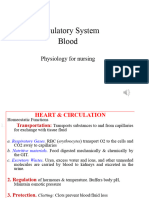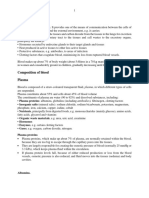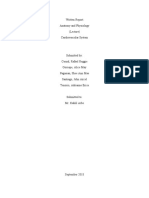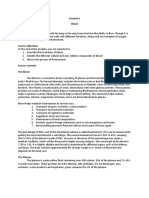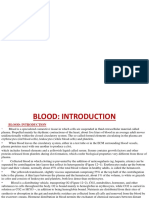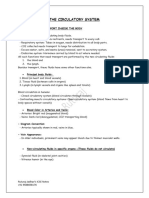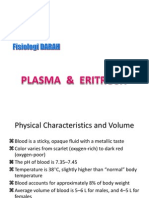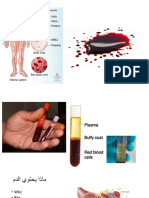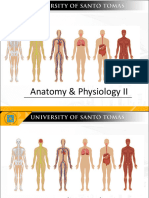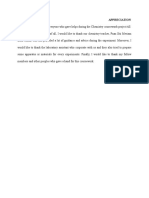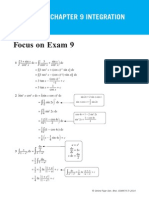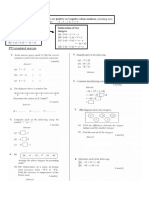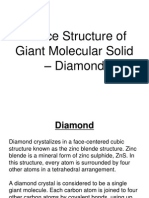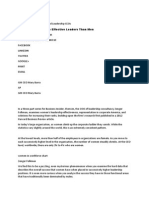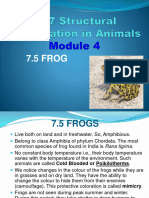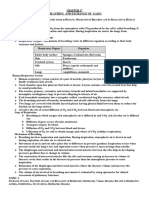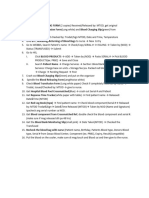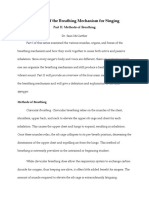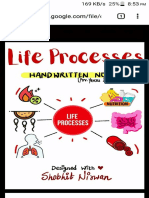0 ratings0% found this document useful (0 votes)
104 viewsBiology 12 - Chapter 11 - Blood - Chapter Notes: Here Is A Micrographs Showing Formed Elements in Human Blood
Biology 12 - Chapter 11 - Blood - Chapter Notes: Here Is A Micrographs Showing Formed Elements in Human Blood
Uploaded by
Chan KarlokBlood functions to transport gases, nutrients, wastes, and fight infections throughout the body. It is composed of plasma and formed elements including red blood cells, white blood cells, and platelets. Red blood cells contain hemoglobin which carries oxygen and carbon dioxide. White blood cells help fight infection. When an injury occurs, platelets, fibrinogen, and other proteins in the blood initiate clotting to prevent blood loss.
Copyright:
© All Rights Reserved
Available Formats
Download as PDF, TXT or read online from Scribd
Biology 12 - Chapter 11 - Blood - Chapter Notes: Here Is A Micrographs Showing Formed Elements in Human Blood
Biology 12 - Chapter 11 - Blood - Chapter Notes: Here Is A Micrographs Showing Formed Elements in Human Blood
Uploaded by
Chan Karlok0 ratings0% found this document useful (0 votes)
104 views7 pagesBlood functions to transport gases, nutrients, wastes, and fight infections throughout the body. It is composed of plasma and formed elements including red blood cells, white blood cells, and platelets. Red blood cells contain hemoglobin which carries oxygen and carbon dioxide. White blood cells help fight infection. When an injury occurs, platelets, fibrinogen, and other proteins in the blood initiate clotting to prevent blood loss.
Original Description:
bio - blood
Original Title
Blood
Copyright
© © All Rights Reserved
Available Formats
PDF, TXT or read online from Scribd
Share this document
Did you find this document useful?
Is this content inappropriate?
Blood functions to transport gases, nutrients, wastes, and fight infections throughout the body. It is composed of plasma and formed elements including red blood cells, white blood cells, and platelets. Red blood cells contain hemoglobin which carries oxygen and carbon dioxide. White blood cells help fight infection. When an injury occurs, platelets, fibrinogen, and other proteins in the blood initiate clotting to prevent blood loss.
Copyright:
© All Rights Reserved
Available Formats
Download as PDF, TXT or read online from Scribd
Download as pdf or txt
0 ratings0% found this document useful (0 votes)
104 views7 pagesBiology 12 - Chapter 11 - Blood - Chapter Notes: Here Is A Micrographs Showing Formed Elements in Human Blood
Biology 12 - Chapter 11 - Blood - Chapter Notes: Here Is A Micrographs Showing Formed Elements in Human Blood
Uploaded by
Chan KarlokBlood functions to transport gases, nutrients, wastes, and fight infections throughout the body. It is composed of plasma and formed elements including red blood cells, white blood cells, and platelets. Red blood cells contain hemoglobin which carries oxygen and carbon dioxide. White blood cells help fight infection. When an injury occurs, platelets, fibrinogen, and other proteins in the blood initiate clotting to prevent blood loss.
Copyright:
© All Rights Reserved
Available Formats
Download as PDF, TXT or read online from Scribd
Download as pdf or txt
You are on page 1of 7
At a glance
Powered by AI
The key takeaways are that blood transports nutrients, gases, wastes and plays a role in clotting and fighting infections. It is made up of plasma and formed elements including red blood cells, white blood cells and platelets.
The main components of blood are plasma, red blood cells, white blood cells, and platelets.
The main functions of blood are transport, clotting, and fighting infections.
BIOLOGY 12 - CHAPTER 11 - BLOOD - CHAPTER NOTES
Raycroft ! Notes - Blood - Student - Page 1 of 7
Human beings are approximately 70% WATER by body weight. Where is all this water?
Most of this water is within cells, while a smaller amount is found within:
A. TISSUE FLUID (surrounds cells
B. LYMPH (within lymph vessels)
C. BLOOD VESSELS
BLOOD is required by the body to maintain homeostasis. Blood is a liquid connective tissue. Blood
functions in a) TRANSPORT (of gases, wastes, and nutrients) b) CLOTTING (to seal injuries) c)
INFECTION FIGHTING. Average person has about 5 to 6 liters of blood.
If blood is allowed to sit in a test tube without clotting, it will divide into TWO MAIN PARTS:
A. PLASMA (the liquid portion of blood) - makes up about 55% of blood volume. Contains water and organic
and inorganic substances (proteins, gases, salts, nutrients, wastes).
B. FORMED ELEMENTS: the "solid part" of blood, consists of the following parts.
a. RED BLOOD CELLS (ERYTHROCYTES)
Transport oxygen, formed in bone marrow. Over 95% of formed elements are erythrocytes.
b. WHITE BLOOD CELLS (LEUKOCYTES)
Fight infection, formed in bone marrow and lymphoid tissue.
c. PLATELETS (THROMBOCYTES)
Function in blood clotting
The white blood cells can also be classified according to their appearance.
Erythrocytes Leukocytes Thrombocytes
Red Blood Cells White Blood Cells Platelets
Granular
Leukocytes
Agranular
Leukocytes
Basophils Monocytes
Eosinophil Lymphocytes
Neutrophil
Blood Proteins
Plasma Constituent Function Source
Water Maintains blood volume and transports molecules Absorbed from large intestine
Plasma Proteins
a. Albumin
b. Fibrinogen
c. Globulins
All maintain blood osmotic pressure & pH
Transport
Clotting
Fight Infection
Liver
Liver
Lymphocytes
Gases
a. Oxygen
b. CO
2
Cellular Respiration
End product of metabolism
Lungs
Tissues
Nutrients: Fats, glucose, amino acids, etc. Food for cells Absorbed from intestinal villi
Salts Maintain blood osmotic pressure/pH, aid metabolism Absorbed from intestinal villi
Wastes End products of metabolism Tissues
Hormones, vitamins etc. Aid metabolism Varied
Here is a micrographs showing formed elements in human blood
Platelets
Erythrocytes
Granular
Leucocytes
Agranular
Leucocytes
Raycroft ! Notes - Blood - Student - Page 2 of 7
Are required for the transport of many molecules. For example, cholesterol is a lipid that is insoluble in
plasma. It must be carried by proteins.
HDL (high-density lipoprotein) is better than LDL for binding with cholesterol, according to some studies, in
the prevention of atherosclerosis.
Blood proteins also contribute to the viscosity of blood (blood is thicker than water), which aids in
transport.
Blood proteins also contribute to osmotic pressure, which maintains blood volume.
Hemoglobin
O
2
is carried by Hemoglobin, which is made of 4 amino acid chains (2 alpha () and 2
beta ()). Each chain has iron-containing heme group which attaches to oxygen.
Hemoglobin is an excellent carrier of oxygen because it weakly binds with oxygen in
the cool, neutral conditions in the lungs, and easily gives O
2
up in the warmer and
more acidic tissues.
Hemoglobin is always contained within red blood cells. Since hemoglobin is a red
pigment, red blood cells appear red. This colour can change based on what the
hemoglobin is attached to.
OXYHEMOGLOBIN (hemoglobin bound to oxygen, abbreviated as HbO
2
) is bright red, while REDUCED
HEMOGLOBIN (hemoglobin that has lost its oxygen) is dark purple.
Carbon Monoxide (CO) is a poison found in car exhaust. It binds to Hb better than oxygen, and stays
bound for several hours regardless of the environmental conditions. CO poisoning can lead to death.
Hemoglobin picks O
2
up in the
lungs and releases O
2
in tissues.
Meanwhile, CO
2
and wastes
diffuse out of cells. What this
means is that there are all sorts
of diffusing molecules going in
and out of the blood and cells.
We should understand how this
works and what drives the
movement of molecules. The
main answer lies in battle of
blood pressure versus osmotic
pressure. The pressure of blood
in blood vessel would tend to
push molecules out of the blood.
Osmotic pressure is the opposing
force trying to force molecules
into the blood. Osmotic pressure
is basically constant, but blood
pressure varies considerable
around a capillary bed. This
causes some natural movement
of molecules.
At the arterial side of a capillary,
blood pressure is higher than
the osmotic pressure and
therefore water, oxygen and
glucose tend to leave the bloodstream.
At the venous end of a capillary, the osmotic pressure is higher than the blood pressure and, therefore,
water, ammonia, and carbon dioxide tend to enter the bloodstream.
Reduced hemoglobin can now pick up CO
2
to form carbaminohemoglobin (HbCO
2
).
However, most CO
2
transported as BICARBONATE ION ( = HCO
3
-
), which is formed after CO
2
combines
with water, forming carbonic acid which then dissociates. Note the following reaction:
CO
2
+ H
2
O <--->H
2
CO
3
<--->H
+
+ HCO
3
-
The enzyme CARBONIC ANHYDRASE speeds up this reaction.
In the diagram above, the blood at point X would likely contain a relatively high
concentration of a) urea b) oxygen c) carbon dioxide d) bicarbonate ions
WATER
GLUCOSE
amino acids
O
2
WATER
CO
2
waste
molecules
Raycroft ! Notes - Blood - Student - Page 3 of 7
The H
+
released by the above reaction could wreak havoc on blood pH. To prevent this H
+
is picked up by
the globin portion of hemoglobin (to become HHb) so that pH is maintained.
Red Blood Cells
There are close to 30 trillion blood cells in an adult. Each cubic millimeter
of blood contains from 4 1/2 to 5 1/2 million red blood cells and an average
total of 7,500 white blood cells. In humans, red blood cells are small,
biconcave, disk-shaped cells without nuclei.
Red blood cells are made by cells called STEM CELLS in red bone
marrow (over 2 million per second!) of the skull, ribs, vertebrae, and
ends of the long bones. Here, Stem Cells continuously divide. During the
maturation process, a red blood cell loses its nucleus and gets much
smaller.
Oxygen levels in blood determine the rate of RBC formation. When oxygen tension is low, the kidneys
produce a chemical called renal erythropoietic factor (REF) that, after combining with globulin from the
liver, causes the bone marrow to produce more RBC.
RBC live for only 120 days and then are destroyed in the liver and spleen. The iron is recovered from the
hemoglobin and sent to the bones, while the heme portion is chemically degraded and is excreted by the
liver in the bile as bile pigments.
BLOOD CLOTTING
After an injury, coagulation "or
clotting" takes place to prevent
excessive blood loss.
This requires the action of 1) platelets
2) prothrombin, and 3) fibrinogen.
Platelets result from fragmentation of
large cells called megakaryocytes in
red bone marrow. You have more than
a trillion in your blood.
Fibrinogen and prothrombin are
plasma proteins manufactured and
deposited in the blood by the liver
(vitamin K is required for the
production of prothrombin)
Here is a simplified summary of the
steps involved in clot formation:
1. Platelets clump at the site of the
puncture and partially seal the leak.
2. Platelets and injured tissues release
the enzyme prothrombin activator
that activates prothrombin to
thrombin. Calcium ions (Ca
++
) are
necessary for this step.
3. Thrombin acts as an enzyme and
severs two short a.a. chains from each
fibrinogen molecule.
4. These activated chains join end to end
to form long ends of fibrin.
5. Fibrin threads entangle red cells and
platelets in the damaged area and
form the framework of the clot.
Red cells trapped in the clot give it its
red colour.
Clotting takes place faster at warmer
temperatures than cold because it is
Injured tissues and platelets
release Prothombin Activator
(an enzyme) (vitamin K required
for the production of Prothombin)
Prothrombin
Activator
Prothrombin Activator
catalyzes the conversion of
Prothrombin to Thrombin.
(Ca
++
is necessary for this step)
Prothrombin
Thrombin
+ Ca
++
Thrombin is an enzyme
that acts like a pair of
scissors, cutting short
amino acid ends off
Fibrinogen molecules
Fibrinogen Fibrin Fragment
Fibrin Fragments join together
end to end to form long fibers.
Fibrin fibers form the
framework of the clot.
Raycroft ! Notes - Blood - Student - Page 4 of 7
controlled by enzymes.
Serum is plasma from which the fibrinogen has been removed due to clotting.
A fibrin clot is only a temporary repair. Eventually, an enzyme called plasmin destroys the fibrin network
and restores the fluidity of plasma.
INFECTION FIGHTING: another major function of blood
The body's first line of defense against invading pathogens like bacteria and viruses is the skin.
The second line of defense is the blood: specifically, white blood cells and gamma globulins.
WHITE BLOOD CELLS
White blood cells are usually larger than RBC (8 - 20 m), have a nucleus, and appear white (if not stained --
when stained, they appear bluish).
Much less numerous than RBC (only 7,000 to 8,000 cells per cubic millimeter). White blood cells, called
leukocytes, are outnumbered by the red blood cells 600 to 1.
There are two main types of Leukocytes:
1. Granulocytes: have granules in the cytoplasm and a many-lobed nucleus joined by nuclear threads (called
"polymorphonuclear"). The granulocytes include Neutrophils (phagocytizes primarily bacteria),
Eosinophils (phagocytizes and destroys antigen-antibody complexes), and Basophils (congregates in
tissues, releases histamine when stimulated). Formed in the red bone marrow. The granules of a neutrophil
are lysosomes.
2. Agranulocytes: Include Lymphocytes and Monocytes. They don't have granules, and have a circular
(lymphocytes) or indented (monocytes) nucleus. They are produced in lymphoid tissue found in the
spleen, lymph nodes, and tonsils. Tye B lymphocytes produce antibodies in blood and lymph, Type T
lymphocytes kill virus-containing cells. Monocytes become macrophages.
Infection fighting by white cells is primarily dependent on the neutrophils, which comprise 60 to 70% of all
leukocytes, and the lymphocytes (which make up 25 to 30%).
Neutrophils, monocytes, and eosinophils are phagocytic. They engulf invaders at the site of infection.
Lymphocytes don't work this way. They secretea class of gamma globulins (proteins) called
IMMUNOGLOBULINS (=ANTIBODIES), which combine with foreign substances to inactivate them.
Lymphocytes are the smallest white blood cells. When microbes invade the body, lymphocytes begin to
multiply and they become transformed plasma cells. Each microbe stimulates only one type of lymphocyte
to multiply and form one type of plasma cell. The type of plasma cell formed is the type that can make a
specific antibody to destroy the particular microbe that has invaded the body.
Red bone marrow continually produces white blood cells, except lymphocytes and monocytes, and keeps a
reserve ready in case of need. Lymphocytes and monocytes are produced by lymphatic tissue located in the
lymph nodes and spleen. When a parasite or virus invades and begins to colonize, the reserves of white
blood cells are released and the manufacturing of large quantities of the appropriate white cells begins. It is
this increased production that causes fever. Because white blood cells are very specific for various
illnesses, their count can help doctors diagnose patients.
ANTIBODIES: very specific proteins that attach to
invading pathogens
Lymphocytes produce antibodies in response to
invading pathogens.
Each lymphocyte produces one type of antibody that is
specific for one type of antigen. An antigen is a foreign
substance (usually a protein, sometimes a carbohydrate)
that stimulates the release of antibodies to it. e.g. an
antigen could be protein coat of a virus.
Antibodies combine with antigens in such a way that the
antigens are rendered harmless. Each antibody fits its
antigen like a lock and key.
An individual is immune to an antigen if he/she has
antibodies to that particular antigens.
The blood in the individual contains lymphocytes that can
remain in the system for years, ready to produce
antibodies if that antigen is detected.
Light chain
Heavy Chain
Variable Region
Constant Region
STRUCTURE OF AN ANTIBODY
Antibodies binding to
antigens (proteins on
surface of a cell)
Raycroft ! Notes - Blood - Student - Page 5 of 7
Exposure to the antigen, either naturally or by way of a vaccine, can cause active immunity to develop.
Diseases will often cause an increase in a particular type of white cell. e.g. mononucleosis characterized
by greater #'s of dark staining lymphocytes. Leukemia is a form of cancer characterized by uncontrolled
production of abnormal white cells, which accumulate in the bone marrow, lymph nodes, spleen, and liver,
causing them to malfunction. Leukemia patients often have severe anemia, clotting difficulties, and
succumb to many infections.
THE INFLAMMATORY REACTION
Whenever the skin is broken due to a minor injury, a series of events occur that are known as the
inflammatory response
because there is swelling and
reddening at the site of the
injury. This response is designed
to get the body's defenses
marshaled as quickly as
possible at the site where they
are needed.
1. When blood vessels and tissue
cells get ruptured by an injury,
they release precursors of
BRADYKININ, a chemical with
several jobs: 1) it initiates nerve
impulses ---> this results in PAIN
2) bradykinin causes MAST
CELLS (a type of cell that resides
in tissues that is derived from
Basophils) to release histamine,
which together with bradykinin
causes a capillary to become
enlarged and more permeable.
2. the enlarged capillary causes the
skin to redden and its increased
permeability allows proteins and
fluids to escape so that swelling
results.
3. Meanwhile, bacteria and viruses
are also entering through the
rupture.
4. Lymphocytes release antibodies
that attack the invading
pathogens, preparing them for
phagocytosis by neutrophils or
monocytes.
5. Once monocytes have arrived on
the scene, they swell up to five to
ten times their original size and
become macrophages (large
phagocytic cells that are able to
devour a hundred invaders and
still survive).
Dead neutrophils plus cells,
bacteria, and WBC form pus, a
thick yellowish fluid.
BLOOD TYPING
Human blood is classified
Injured tissues and capillaries
release factors that form
BRADYKININ.
Bradykinin:
1. stimulates nerves (pain)
2. causes MAST CELLS
(derived from basophils)
to release HISTAMINE.
Mast Cell
Mast Cells release histamine
Histamine causes capilliaries
to dilate, enlarge, and become
more permeable (bradykinin
helps increase this effect).
Enlarged capillaries causes
the skin to redden, and its
increased permeability allows
proteins and fluids to escape,
so that swelling results.
Neutrophils and monocytes are
amoeboid; they can change shape
and squeeze through enlarged
capillary walls to enter tissue fluid.
Neutrophils
phagocytize
bacteria.
Monocytes become
MACROPHAGES, which
are large cells that are
great at phagocytosis and
also stimulate the release
of other white blood cells
from bone marrow.
Macrophages eat up old
blood cells, bits of dead
tissue, bacteria, debris.
The battlefield debris called pus consists of dead
and living leukocytes, dead cells, tissue, and bacteria.
The inflammatory response is a 911 call to the immune system. It
marshalls phagocytic white blood cells to the site of invasion by bacteria
Raycroft ! Notes - Blood - Student - Page 6 of 7
according to the antigens present on the surface of the red blood cells. The most common blood types
belong to the ABO Grouping.
Two antigens that may be present on the red cells are called "A" and "B". An individual may have one of
these antigens present (in which case they will have type A or type B blood), or both (type AB) or neither
(type O). Therefore, there are four blood types in the ABO Grouping.
Each individual also carries antibodies in his/her plasma to the antigens not present on that individual's red
cells. e.g. Type A blood has antibody b, Type AB blood has no antibodies.
If the same antigen and antibody are present, AGGLUTINATION (or clumping) of red cells will occur (can
cause death).
Blood recipients may only receive donated blood for which they have no antibodies in their plasma.
This test indicates is B
+
blood type.
A
A
A
A
B
B
B
B
B
B
A
A
TYPE A BLOOD
has type A antigens
makes type b antibodies
(antibodies that attack B
antigens)
a
TYPE B BLOOD
has type B antigens
makes type a antibodies
(antibodies that attack A
antigens)
TYPE AB BLOOD
has both A & B antigens
makes NO ANTIBODIES to
A or B antigens.
b
TYPE O BLOOD
has neither A nor B antigens
makes both type a and type b
antibodies
Rh
A
B Rh
Rhesus Antigen (Rh factor)
Rh factor is another antigen
that can be present on RBC.
Either you have it (+) or
you dont (-)
If you are Rh negative, you
dont make antibodies to Rh
unless you have been exposed
to it.
The person above is Rh
+
Raycroft ! Notes - Blood - Student - Page 7 of 7
Type Antigen Antibody %U.S. Black %U.S. Caucasian
A A b 25 41
B B a 20 7
AB A,B none 4 2
O none a,b 51 50
The Rh System
Another important antigen in matching blood types is the Rh factor (another antigen found on red blood cells)
People with this particular antigen on the red cells are Rh positive; those without it are Rh negative.
Rh negative individuals do not normally make antibodies to the Rh factor, but they will make them when
exposed to the Rh factor. It is possible to extract these antibodies and use them for blood type testing,
since Rh positive blood will agglutinate when mixed with Rh antibodies.
The Rh factor is very important during pregnancy. If the mother is Rh negative and the father is Rh
positive, the child may be Rh positive. During gestation, it is normal that a few red cells from the child will
find their way into the mother's system -- she will then produce Rh antibodies.
If the mother becomes pregnant with another Rh positive baby, Rh antibodies my cross the placenta
and destroy the child's red cells. This is called FETAL ERYTHROBLASTOSIS.
Current treatment: give Rh
-
women an Rh immune globulin injection (like an injection of antibodies) called
RhoGAM just after the birth of any Rh
+
child. This injection will DESTROY ANY RED CELLS left over from
the baby, BEFORE the mother has a chance to start producing her own antibodies.
The injection won't work if the woman has already started to produce her own antibodies.
For Example: A
-
mother X O
+
father could
produce A
+
baby.
Rh
A
A Rh
A few of babys blood cells
get into mother just before
or during childbirth.
Mom then produces
antibodies to the Rh factor
Rh
If she gets pregnant with another
Rh
+
baby, her anti-Rh antibodies
can cross placenta during
pregancy and cause agglutination
of babys RBC -- can seriously
harm or kill the baby.
Rh
A
A Rh
Treatment: immediately after
birth of Rh
+
baby, give mother
injection of RhoGAM. It contains
Rh antibodies that destroy any of
the babys RBC left in the
mother before she can produce
antibodies to Rh factor.
A
+
You might also like
- Chapter 30 Nursing Assessment Hematologic SystemDocument14 pagesChapter 30 Nursing Assessment Hematologic Systemmedic-24100% (3)
- Anatomy and Physiology of BloodDocument9 pagesAnatomy and Physiology of BloodLharra Cagulada-PostranoNo ratings yet
- Seeley's Chapter 8 Nervous SystemDocument100 pagesSeeley's Chapter 8 Nervous SystemChristine Tapawan89% (9)
- Blood and Its Components-NotesDocument10 pagesBlood and Its Components-NotesKelvin RequenaNo ratings yet
- Blood Composition and Functions: Indian Institute of Technology PatnaDocument41 pagesBlood Composition and Functions: Indian Institute of Technology PatnaHritik KumarNo ratings yet
- PSG 712 Blood-1Document54 pagesPSG 712 Blood-1preciousNo ratings yet
- BLOOD Update-1Document56 pagesBLOOD Update-1ahmadfadi343No ratings yet
- TransportationDocument58 pagesTransportatione-SayutiNo ratings yet
- Biochemistry of Diseases Dr. Jishnunil Chakraborty: Analytical Clinical Biochemistry (Sec-A2)Document28 pagesBiochemistry of Diseases Dr. Jishnunil Chakraborty: Analytical Clinical Biochemistry (Sec-A2)Pedro SilvaNo ratings yet
- Biochemistry of Diseases Dr. Jishnunil Chakraborty: Analytical Clinical Biochemistry (Sec-A2)Document21 pagesBiochemistry of Diseases Dr. Jishnunil Chakraborty: Analytical Clinical Biochemistry (Sec-A2)Pedro SilvaNo ratings yet
- Anatomy & Physiology (Chapter 11 - Blood)Document22 pagesAnatomy & Physiology (Chapter 11 - Blood)Eliezer NuenayNo ratings yet
- Blood: - Enzymes, E.G. Certain Clotting FactorsDocument14 pagesBlood: - Enzymes, E.G. Certain Clotting FactorsDerrick kinyaNo ratings yet
- Blood FinalDocument14 pagesBlood FinalAnkit PattnayakNo ratings yet
- Blood ProjectDocument15 pagesBlood Projecttarun8thstdcapableNo ratings yet
- Cardiovascular SystemDocument6 pagesCardiovascular Systemchristianoliver.aceroNo ratings yet
- Blood and Clotting FactorsDocument34 pagesBlood and Clotting FactorsAnand KasiNo ratings yet
- Anatomy and Physiology of BloodDocument10 pagesAnatomy and Physiology of Bloodaoi_rachelle100% (1)
- Blood CirculatoryDocument5 pagesBlood CirculatoryRekesh SaeedNo ratings yet
- Written Report Copy BloodDocument29 pagesWritten Report Copy BloodNathalieCaracaNo ratings yet
- Lecture-2 Red Blood CellDocument17 pagesLecture-2 Red Blood Cellaksam.safoan.008No ratings yet
- Chapter 17 Blood and 18 Review AnswersDocument4 pagesChapter 17 Blood and 18 Review Answersmamun0zNo ratings yet
- Blood Anatomy Physiology HandoutsDocument6 pagesBlood Anatomy Physiology HandoutsKids JangNo ratings yet
- HAPP Supplementary Notes - BloodDocument14 pagesHAPP Supplementary Notes - BloodZuhri PorzaNo ratings yet
- Blood and Immune SystemDocument34 pagesBlood and Immune SystemIrene VuremyNo ratings yet
- Components of BloodDocument19 pagesComponents of Bloodrenaebroomfield43No ratings yet
- Blood Overview and IntroductionDocument8 pagesBlood Overview and IntroductionKathleen Joy Costales MagtanongNo ratings yet
- Blood and Immunity PowerpointDocument94 pagesBlood and Immunity Powerpointapi-263357086100% (1)
- Physiology of BloodDocument97 pagesPhysiology of Bloodbelete psychiatry100% (7)
- 4 Blood PhysiologyDocument79 pages4 Blood Physiologysefiw.amareNo ratings yet
- Blood Anatomy and PhysiologyDocument4 pagesBlood Anatomy and PhysiologyRao Asad MubeenNo ratings yet
- Gjaku Dhe HemopoezaDocument56 pagesGjaku Dhe HemopoezaGent'No ratings yet
- Blood: - The Only Fluid Tissue in The Human Body - Classified As A Connective TissueDocument39 pagesBlood: - The Only Fluid Tissue in The Human Body - Classified As A Connective TissueJorNo ratings yet
- Circulatory SystemDocument6 pagesCirculatory Systemraj.cacscmaNo ratings yet
- CH 15 BloodDocument6 pagesCH 15 Bloodsann1992No ratings yet
- Physiology (Unit 3)Document308 pagesPhysiology (Unit 3)Ahmed HashmiNo ratings yet
- Circulatory SystemDocument74 pagesCirculatory SystemMICHAEL AFIADENYONo ratings yet
- Transport System I - UnlockedDocument21 pagesTransport System I - Unlockeddannieycandiey44No ratings yet
- Fisiologi DARAHDocument31 pagesFisiologi DARAHTririn RinantiNo ratings yet
- The Circulatory System 2. 1 Composition and Function of BloodDocument29 pagesThe Circulatory System 2. 1 Composition and Function of BlooddevNo ratings yet
- Blood and Body FluidsDocument24 pagesBlood and Body FluidsQasim NaeemNo ratings yet
- CH 19 - The Blood - SV Complete (1) Kin 267 Module 7Document53 pagesCH 19 - The Blood - SV Complete (1) Kin 267 Module 7J aNo ratings yet
- Práctica RespiratorioDocument10 pagesPráctica Respiratorioandrea.valencia5411No ratings yet
- Haematology: Presented By: Prof - Mirza Anwar BaigDocument154 pagesHaematology: Presented By: Prof - Mirza Anwar BaigHabib UllahNo ratings yet
- Chapter 17 Anatomy and Physiology NotesDocument10 pagesChapter 17 Anatomy and Physiology NotesZachary WatsonNo ratings yet
- Chapter 31 BloodDocument27 pagesChapter 31 Bloodx55jn6xgbhNo ratings yet
- Blood Lecture NotesDocument10 pagesBlood Lecture NotesSimonNo ratings yet
- Blood Anatomy and PhysiologyDocument23 pagesBlood Anatomy and PhysiologyNatukunda DianahNo ratings yet
- Blood Lectie Generala Eng-2454Document56 pagesBlood Lectie Generala Eng-2454IngaŞaragovNo ratings yet
- BLOODDocument11 pagesBLOODshapan biswaNo ratings yet
- Blood Vascular SystemDocument29 pagesBlood Vascular Systemgarimaupadhyay20002No ratings yet
- University of Guyana Health Sciences FacultyDocument44 pagesUniversity of Guyana Health Sciences FacultySatrohan SurjnarineNo ratings yet
- Blood: Blood Maintains Homeostasis To The Ff. FunctionsDocument21 pagesBlood: Blood Maintains Homeostasis To The Ff. FunctionsShekinah Lynn A. PocdolNo ratings yet
- 10 Cardiovasclar SystemDocument199 pages10 Cardiovasclar SystemjopermongcalNo ratings yet
- Blood Basic and AnemiaDocument10 pagesBlood Basic and AnemiaMaqbul AlamNo ratings yet
- Chapter 4 Blood Coagulation and Coagulation DisordersDocument27 pagesChapter 4 Blood Coagulation and Coagulation DisordersdaisysintszwaiNo ratings yet
- Human Circulatory System L2.2Document53 pagesHuman Circulatory System L2.2SUBSCRIBE TO PewDiePieNo ratings yet
- 9 Anatomy 2021 BloodDocument32 pages9 Anatomy 2021 BloodDanica DaniotNo ratings yet
- CVS BloodDocument39 pagesCVS BloodMohan GuptaNo ratings yet
- Anatomi Fisiologi Manusia: HematologiDocument54 pagesAnatomi Fisiologi Manusia: HematologiARUMNo ratings yet
- A Simple Guide to the Blood Cells, Related Diseases And Use in Disease DiagnosisFrom EverandA Simple Guide to the Blood Cells, Related Diseases And Use in Disease DiagnosisNo ratings yet
- Testing The PH of Soil Samples: ReferenceDocument1 pageTesting The PH of Soil Samples: ReferenceChan KarlokNo ratings yet
- Appreciation I Would Like To Thank Everyone Who Gave Helps During The Chemistry Coursework Project TillDocument1 pageAppreciation I Would Like To Thank Everyone Who Gave Helps During The Chemistry Coursework Project TillChan KarlokNo ratings yet
- Women Make Better Leaders Than Men@@Document2 pagesWomen Make Better Leaders Than Men@@Chan Karlok100% (1)
- Chapter 09 FWSDocument31 pagesChapter 09 FWSChan KarlokNo ratings yet
- Chapter 6: Integers Integers: PT3 Orientated ExerciseDocument4 pagesChapter 6: Integers Integers: PT3 Orientated ExerciseChan KarlokNo ratings yet
- Bibliography 1. Wikipedia: Quadrant: /quadrat - Transects PDFDocument3 pagesBibliography 1. Wikipedia: Quadrant: /quadrat - Transects PDFChan KarlokNo ratings yet
- Focus On Exam 7: Chapter 7 Limits and ContinuityDocument7 pagesFocus On Exam 7: Chapter 7 Limits and ContinuityChan KarlokNo ratings yet
- Chapter 8 FWSDocument32 pagesChapter 8 FWSChan KarlokNo ratings yet
- MuetDocument28 pagesMuetChan KarlokNo ratings yet
- Lattice Structure of Giant Molecular Solid - DiamondDocument6 pagesLattice Structure of Giant Molecular Solid - DiamondChan KarlokNo ratings yet
- Malaria - by Prototist Plasmodium, Vector Female Anopheles Mosq Causative AgentsDocument2 pagesMalaria - by Prototist Plasmodium, Vector Female Anopheles Mosq Causative AgentsChan KarlokNo ratings yet
- Bio 12 Plo b9 and b10 Transport Across Cell Membrane Vocabulary SolutionsDocument4 pagesBio 12 Plo b9 and b10 Transport Across Cell Membrane Vocabulary SolutionsChan KarlokNo ratings yet
- Women Leader Muet EssayDocument6 pagesWomen Leader Muet EssayChan KarlokNo ratings yet
- DNA and Protein Synthesis - Chapter Notes: "Life Is A Three Letter Word!"Document13 pagesDNA and Protein Synthesis - Chapter Notes: "Life Is A Three Letter Word!"Chan Karlok100% (1)
- Higher Education in Taiwan: GPN: 2010101411 PRICE: NT$250 US$8Document37 pagesHigher Education in Taiwan: GPN: 2010101411 PRICE: NT$250 US$8Chan KarlokNo ratings yet
- Aa STPM Chemistry T1 2012Document5 pagesAa STPM Chemistry T1 2012Chan KarlokNo ratings yet
- ABO and RH Blood Group SystemDocument31 pagesABO and RH Blood Group SystemKaab Ishaq100% (1)
- Class - XI - Biology - Structural Orgganization in Animals M 4Document20 pagesClass - XI - Biology - Structural Orgganization in Animals M 4Anshu RajNo ratings yet
- Breathing and Exchange of GasesDocument5 pagesBreathing and Exchange of Gaseslpc4944No ratings yet
- 4.oxygen ConsumptionDocument22 pages4.oxygen ConsumptionAlejandro EVNo ratings yet
- Blood MCQDocument32 pagesBlood MCQHashim Omar92% (12)
- Part of BodyDocument4 pagesPart of Bodyanon_535068952No ratings yet
- Unit 2 Biology and Geology 3rd ESODocument64 pagesUnit 2 Biology and Geology 3rd ESOPaulaNo ratings yet
- Breathing & Exchange of Gases NotesDocument7 pagesBreathing & Exchange of Gases NotesKankana Biswas100% (1)
- Practica Reproducitve Systme and PresentDocument10 pagesPractica Reproducitve Systme and PresentLauris CassoNo ratings yet
- Blood BankDocument4 pagesBlood Bankfritzie dara f adjilaniNo ratings yet
- Respiration PDFDocument30 pagesRespiration PDFsarvesh kumarNo ratings yet
- Immunology: Lymphoid Organs Sr. Sarupya Mercy College PalakkadDocument28 pagesImmunology: Lymphoid Organs Sr. Sarupya Mercy College PalakkadTahir AzizNo ratings yet
- Respiratory Physiology PostedDocument25 pagesRespiratory Physiology PostedYeni PuspitaNo ratings yet
- ML, Target Haemoglobin 80g/L: Use Charts To Estimate The Aximum Llowable Lood Oss To Produce A Post-Op HB of 80 or 100g/LDocument2 pagesML, Target Haemoglobin 80g/L: Use Charts To Estimate The Aximum Llowable Lood Oss To Produce A Post-Op HB of 80 or 100g/LcringlesoreosNo ratings yet
- Phylum Mollusca 1 ReviewerDocument10 pagesPhylum Mollusca 1 ReviewerRhona QuistoNo ratings yet
- Chap 37Document13 pagesChap 37buatadekNo ratings yet
- Temperature Pulse + RespirationsDocument2 pagesTemperature Pulse + RespirationsMarshin Thea Celocia100% (1)
- Body Parts Governed by PlanetsDocument2 pagesBody Parts Governed by PlanetsBratva Ankit Mishra100% (1)
- Anaphysio of BreastDocument3 pagesAnaphysio of BreastVictor BiñasNo ratings yet
- ANATOMY Study Lower Respiratory TractDocument3 pagesANATOMY Study Lower Respiratory TractLP BenozaNo ratings yet
- A Review of The Breathing Mechanism For SingingDocument7 pagesA Review of The Breathing Mechanism For SingingKasia Brodowska-KlingerNo ratings yet
- Land of NodDocument7 pagesLand of NodMaltesers1976No ratings yet
- Breathing - Handout - AthleteDocument3 pagesBreathing - Handout - AthleteRyan DouglasNo ratings yet
- Logbook For PG PhysiologyDocument42 pagesLogbook For PG Physiologydevdsantosh100% (1)
- CHAPTER - 6 LIFE PROCESSES CLASS XTH 2020-2021Document20 pagesCHAPTER - 6 LIFE PROCESSES CLASS XTH 2020-2021FACTOPEDIANo ratings yet
- Pengaruh Terapi Rendam Kaki Dengan Air Hangat Terhadap Penurunan Tekanan Darah Pada Pasien Dengan Hipertensi Di Puskesmas Bahu ManadoDocument10 pagesPengaruh Terapi Rendam Kaki Dengan Air Hangat Terhadap Penurunan Tekanan Darah Pada Pasien Dengan Hipertensi Di Puskesmas Bahu ManadoMaisa NisaNo ratings yet
- Historia Tartarorum EcclesiasticaDocument4 pagesHistoria Tartarorum EcclesiasticaVladimir SaricNo ratings yet
- Breathing ControlDocument4 pagesBreathing ControltinaNo ratings yet
- Blood TypingDocument2 pagesBlood TypingEnaye MajiriNo ratings yet






